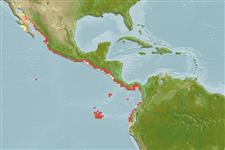Common names from other countries
Environment: milieu / climate zone / depth range / distribution range
экология
морской; солоноватоводный; пределы глубины 0 - 50 m (Ref. 189). Tropical; 30°N - 5°S, 115°W - 76°W (Ref. 189)
Eastern Pacific: Magdalena Bay, Baja California on the Pacific coast and from San Felipe Bay, Gulf of California south to Gulf of Guayaquil, northern Peru.
Length at first maturity / Size / Вес / Возраст
Maturity: Lm 10.8, range 11 - 11 cm
Max length : 25.0 cm TL самец/пол неопределен; (Ref. 96339); common length : 12.5 cm SL самец/пол неопределен; (Ref. 9298); наибольший вес (опубликованные данные): 57.40 g (Ref. 91172)
Краткое описание
определительные ключи | морфология | морфометрия
колючие лучи спинного плавника (общее число) : 0; колючие лучи анального плавника: 0; членистые (мягкие) лучи анального плавника: 26 - 29. Snout moderate, pointed, tip at or just above eye center; maxilla moderate, tip pointed and reaching onto pre-operculum (but not beyond), extending beyond second supra-maxilla; sub-operculum with a distinct triangular projection on hind margin; lower gill rakers fine and slender, increasing in larger fishes. Silver stripe along flank ,probably disappearing in larger fishes.
Occurs inshore along sandy beaches and in tide streams, forming large schools. Juveniles to about 7 cm occur on beaches and in bays, thereafter moving further from the shore. Feeds by filtering phytoplankton and zooplankton.
Spawn in school (Ref. 205).
Whitehead, P.J.P., G.J. Nelson and T. Wongratana, 1988. FAO Species Catalogue. Vol. 7. Clupeoid fishes of the world (Suborder Clupeoidei). An annotated and illustrated catalogue of the herrings, sardines, pilchards, sprats, shads, anchovies and wolf-herrings. FAO Fish. Synop. 125(7/2):305-579. Rome: FAO. (Ref. 189)
Статус Красного Списка МСОП (Ref. 130435)
CITES (Ref. 128078)
Not Evaluated
Угроза для людей
Harmless
Использование человеком
рыболовство: не имеет хозяйственного значения; наживка: usually
дополнительная информация
инструменты
Специальные отчеты
Скачать в формате XML
ресурсы в Интернет
Estimates based on models
Preferred temperature (Ref.
115969): 22.3 - 28.5, mean 26.3 (based on 48 cells).
Phylogenetic diversity index (Ref.
82804): PD
50 = 0.6250 [Uniqueness, from 0.5 = low to 2.0 = high].
Bayesian length-weight: a=0.00617 (0.00407 - 0.00934), b=3.23 (3.11 - 3.35), in cm Total Length, based on LWR estimates for this species & (Sub)family-body (Ref.
93245).
Trophic level (Ref.
69278): 2.7 ±0.30 se; based on food items.
устойчивость к внешним воздействиям (Ref.
120179): высокий, минимальное время удвоения популяции до 15 месяцев (Preliminary K or Fecundity.).
Fishing Vulnerability (Ref.
59153): Low vulnerability (15 of 100).
